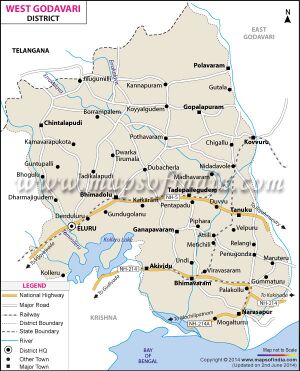Vengi
| Author:Laxman Burdak, IFS (R) |

Vengi (वेंगी) was a historical place of which King Hastivarman was included in the list of the Dakshinapatha kings defeated by Samudragupta. It has been identified with Pedavegi village in West Godavari district in the state of Andhra Pradesh in India, 10 km north of Eluru.
Origin
Variants
- Vegi वेगी = Vengi वेंगी (AS, p.871)
- Vengi वेंगी (AS, p.871)
- Pedavegi (पेडवेगी) (AS, p.871)
- Peddavengi (पेड्डवेगी) (AS, p.871)
- Peddavegi (पेड्डवेगी) (AS, p.871)
- Vengipura (वेंगीपुर)
History
Tej Ram Sharma[1] writes about King Hastivarmman in Allahabad Stone Pillar Inscription of Samudragupta (=A.D.335-76) (L. 2): A king of Vengi (वेंगी) in the time of Samudragupta and included in the list of the Dakshinapatha kings defeated by the latter. He is identical with the king of the Salankayana dynasty whose record has been found at Peddavegi. [2] It is a name based on animal. The name Hastin (elephant) denotes fatness and valour.
Allahabad Stone Pillar Inscription of Samudragupta (A.D. 335-76)
(L. 19.)-Whose great good fortune was mixed with, so as to be increased by (his) glory produced by the favour shewn in capturing and then liberating Mahendra of Kosala, Vyāghraraja of Mahākantāra, Mantarāja of Kurūḷa, Mahendra of Pishtapura, Svāmidatta of Kottura on the hill, Damana of Erandapalla,Vishnugopa of Kānchi,Nīlarāja of Avamukta,Hastivarman of Vengā, Ugrasena of Palakka, Kubera of Devarāshtra, Dhananjaya of Kusthalapura, and all the other kings of the region of the south;-
Alexander Cunningham[3] writes.... Rajamahendri was the capital of the junior, or eastern branch of the Chalukya princes of Vengi, whose authority extended to the frontiers of Orissa. The kingdom of Vengi was established about A.D. 540, by the capture of the old capital of Vengipura, the remains of [p.517]: which still exist at Vegi, 5 miles to the north of Ellur, and 50 miles to the west-south-west of Rajamahendri. About A.D.750, Kalinga was conquered by the Raja of Vengi, who shortly afterwards moved the seat of government to Rajamahendri.
No. 4 Kuruspal Stone Inscription of Somesvaradeva[4] mentions certain contemporary kings, Most of these kings are mentioned here by the names of their countries or capitals, those quite clear being Uḍra, Lanji, Ratnapura, Lemṇa, Vengi, Bhadrapattana and Vajra..... Vengi, the country between the Godavari and Krishna River.
We know Udra to be the old name of Orissa, Lanji, a well-known tract in the district of Balaghat, Ratnapura, the capital of the Haihayas in Dakasina Kosala, and Vengi, the country between the Godavari and Krishna, Lemṇa may be Lavana, the eastern tract of the Raipur district. So far, the inscription does not give us any new information, but the remaining two names, viz. Vajra and Bhadrapattana, are interesting. Vajra or Vayiragaram is mentioned in Tamil literature and inscriptions. 9 The earliest reference to Vajra is perhaps in the Tamil poem Shilappadigāram10 which is believed to have between 110 and 140 A.D. It is stated in this poem that the Chola king Karikāla.
वेंगी
वेंगी (AS, p.871) : गुप्त सम्राट समुद्रगुप्त की प्रयाग-प्रशस्ति में वर्णित वह स्थान जहाँ के शासक हस्तिवर्मन को गुप्त सम्राट ने परास्त किया था- 'वैंगीयकहस्तिवर्मापालक्कउग्रसेनदैव राष्ट्रककुबेरकौस्थलपुरकधनंजयप्रभृति-सर्वदक्षिणापथ राजागृहणमोक्षानुग्रहजनित-प्रतापोन्मिश्रमहाभाग्यस्य च।' वेंगी का अभिज्ञान वेंगी और पेड्डवेगी नामक स्थान से किया गया है. वेंगी कृष्णा नदी और गोदावरी नदी के बीच आन्ध्र प्रदेश में एल्लौर से 7 मील की दूरी पर उत्तर में स्थित है। समुद्रगुप्त के समय वेंगी का राजा हस्तिवर्मन या हस्तिवर्मा था, जो सम्भवतः शालंकायन वंश का था। दूसरी शती ई. में वेंगी के शालंकायन नामक नरेशों का पता चला है। टॉल्मी ने इन्हें ही 'सलकेनोई' नाम से अभिहित किया है। इससे पहले यहां इक्ष्वाकुओं का राज्य था। [5]
External links
References
- ↑ Personal and geographical names in the Gupta inscriptions/Names of Feudatory Kings and High Officers,p.46
- ↑ The Vakatka-Gupta Age by R. C. Majumdar and A.S. Altekar, p. 145.
- ↑ The Ancient Geography of India/Southern India,pp.516-517
- ↑ Epigraphia Indica & Record of the Archaeological Survey of India, Vol.X, 1909-10, p.26
- ↑ Aitihasik Sthanavali by Vijayendra Kumar Mathur, p.871

